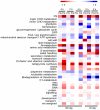Transcriptional response to petiole heat girdling in cassava
- PMID: 25672661
- PMCID: PMC4325323
- DOI: 10.1038/srep08414
Transcriptional response to petiole heat girdling in cassava
Abstract
To examine the interactions of starch and sugar metabolism on photosynthesis in cassava, a heat-girdling treatment was applied to petioles of cassava leaves at the end of the light cycle to inhibit starch remobilization during the night. The inhibition of starch remobilization caused significant starch accumulation at the beginning of the light cycle, inhibited photosynthesis, and affected intracellular sugar levels. RNA-seq analysis of heat-treated and control plants revealed significantly decreased expression of genes related to photosynthesis, as well as N-metabolism and chlorophyll biosynthesis. However, expression of genes encoding TCA cycle enzymes and mitochondria electron transport components, and flavonoid biosynthetic pathway enzymes were induced. These studies reveal a dynamic transcriptional response to perturbation of sink demand in a single leaf, and provide useful information for understanding the regulations of cassava under sink or source limitation.
Figures






Similar articles
-
Exploring sugar allocation and metabolic shifts in cassava plants infected with Cassava common mosaic virus (CsCMV) under long-day photoperiod: diel changes in source and sink leaves.J Plant Res. 2025 Jan;138(1):131-145. doi: 10.1007/s10265-024-01595-4. Epub 2024 Nov 19. J Plant Res. 2025. PMID: 39560817
-
Transcriptome profiling of low temperature-treated cassava apical shoots showed dynamic responses of tropical plant to cold stress.BMC Genomics. 2012 Feb 10;13:64. doi: 10.1186/1471-2164-13-64. BMC Genomics. 2012. PMID: 22321773 Free PMC article.
-
Predominantly symplastic phloem unloading of photosynthates maintains efficient starch accumulation in the cassava storage roots (Manihot esculenta Crantz).BMC Plant Biol. 2021 Jul 3;21(1):318. doi: 10.1186/s12870-021-03088-1. BMC Plant Biol. 2021. PMID: 34217217 Free PMC article.
-
From source to sink: mechanistic insight of photoassimilates synthesis and partitioning under high temperature and elevated [CO2].Plant Mol Biol. 2022 Nov;110(4-5):305-324. doi: 10.1007/s11103-022-01274-9. Epub 2022 May 24. Plant Mol Biol. 2022. PMID: 35610527 Review.
-
Cassava biology and physiology.Plant Mol Biol. 2004 Nov;56(4):481-501. doi: 10.1007/s11103-005-2270-7. Plant Mol Biol. 2004. PMID: 15669146 Review.
Cited by
-
Transcriptome and selected metabolite analyses reveal points of sugar metabolism in the developing leaves of kiwifruit.Front Plant Sci. 2025 Jul 11;16:1618801. doi: 10.3389/fpls.2025.1618801. eCollection 2025. Front Plant Sci. 2025. PMID: 40718028 Free PMC article.
-
Characterization of Sugar Contents and Sucrose Metabolizing Enzymes in Developing Leaves of Hevea brasiliensis.Front Plant Sci. 2018 Feb 1;9:58. doi: 10.3389/fpls.2018.00058. eCollection 2018. Front Plant Sci. 2018. PMID: 29449852 Free PMC article.
-
Genome-wide characterization and expression profiling of HD-Zip gene family related to abiotic stress in cassava.PLoS One. 2017 Mar 1;12(3):e0173043. doi: 10.1371/journal.pone.0173043. eCollection 2017. PLoS One. 2017. PMID: 28249019 Free PMC article.
-
The Discrepant and Similar Responses of Genome-Wide Transcriptional Profiles between Drought and Cold Stresses in Cassava.Int J Mol Sci. 2017 Dec 12;18(12):2668. doi: 10.3390/ijms18122668. Int J Mol Sci. 2017. PMID: 29231846 Free PMC article.
-
Physiological Investigation and Transcriptome Analysis of Polyethylene Glycol (PEG)-Induced Dehydration Stress in Cassava.Int J Mol Sci. 2016 Feb 25;17(3):283. doi: 10.3390/ijms17030283. Int J Mol Sci. 2016. PMID: 26927071 Free PMC article.
References
-
- de Souza C. R., Carvalho L. J. & de Mattos Cascardo J. C. Comparative gene expression study to identify genes possibly related to storage root formation in cassava. Protein. Peptide. Lett. 11, 577–582 (2004). - PubMed
-
- Koch B. M. et al. Possible use of a biotechnological approach to optimize and regulate the content and distribution of cyanogenicglucosides in cassava to increase food safety. International Workshop on Cassava Safety 375, 45–60 (1994).
-
- Taylor N., Raemakers K., Siritunga D. & Zhang P. Development and application of transgenic technologies in cassava. Plant. Mol. Biol. 56, 671–688 (2004). - PubMed
-
- Osunsami A. T., Akingbala J. O. & Oguntimein G. B. Effect of storage on starch content and modification of cassava starch. Starch-Stärke 41, 54–57 (1989).
-
- Angelov M. N., Sun J., Byrd G. T., Brown R. H. & Black C. C. Novel characteristics of cassava, Manihotesculenta Crantz, a reputed C3–C4 intermediate photosynthesis species. Photosynth. Res. 38, 61–72 (1993). - PubMed
Publication types
MeSH terms
Substances
Associated data
LinkOut - more resources
Full Text Sources
Other Literature Sources

